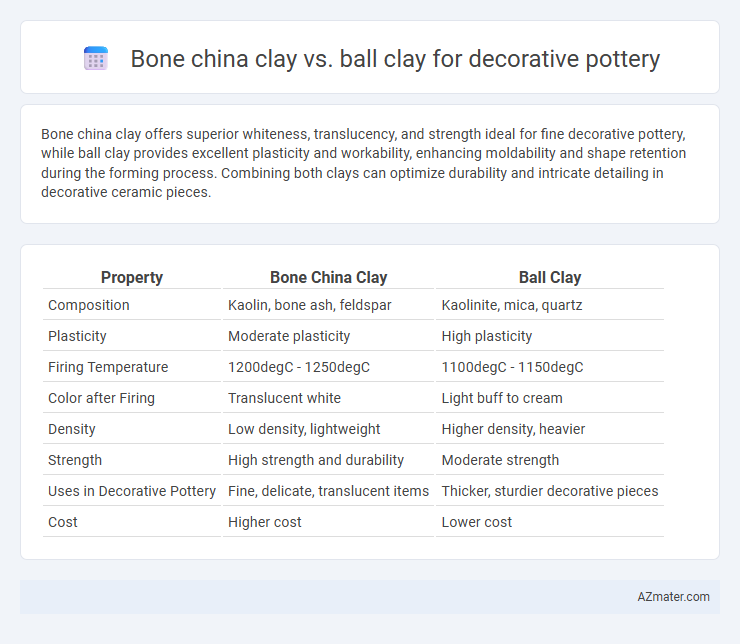Bone china clay offers superior whiteness, translucency, and strength ideal for fine decorative pottery, while ball clay provides excellent plasticity and workability, enhancing moldability and shape retention during the forming process. Combining both clays can optimize durability and intricate detailing in decorative ceramic pieces.
Table of Comparison
| Property | Bone China Clay | Ball Clay |
|---|---|---|
| Composition | Kaolin, bone ash, feldspar | Kaolinite, mica, quartz |
| Plasticity | Moderate plasticity | High plasticity |
| Firing Temperature | 1200degC - 1250degC | 1100degC - 1150degC |
| Color after Firing | Translucent white | Light buff to cream |
| Density | Low density, lightweight | Higher density, heavier |
| Strength | High strength and durability | Moderate strength |
| Uses in Decorative Pottery | Fine, delicate, translucent items | Thicker, sturdier decorative pieces |
| Cost | Higher cost | Lower cost |
Introduction to Bone China Clay and Ball Clay
Bone china clay, a refined mixture containing bone ash, kaolin, and feldspar, is prized in decorative pottery for its translucency, whiteness, and strength, making it ideal for delicate, high-quality ceramics. Ball clay, a highly plastic and fine-grained clay, enhances workability and green strength in pottery, contributing to smooth textures and durability in decorative pieces. Understanding the distinct properties of bone china clay and ball clay helps potters achieve optimal performance and aesthetic appeal in ceramic art.
Composition and Mineral Content
Bone china clay primarily consists of kaolin, feldspar, and bone ash, which imparts translucency and strength to decorative pottery, while ball clay is rich in kaolinite and organic matter, offering high plasticity and workability. The high kaolin content in bone china ensures a pure, white body, whereas ball clay's fine-grained mineral composition enhances flexibility but can introduce impurities affecting firing characteristics. Understanding the distinct mineralogical profiles helps potters select the correct clay for achieving desired aesthetic and functional qualities in decorative ceramics.
Physical Properties Comparison
Bone china clay features a high kaolin content and bone ash, providing excellent whiteness, translucency, and strength with minimal shrinkage during firing. Ball clay contains finer particles and higher plasticity, enhancing workability and flexibility but increasing shrinkage and reducing fired strength. The choice between bone china and ball clay depends on balancing translucency and durability with shaping ease in decorative pottery.
Workability and Molding Characteristics
Bone china clay offers superior plasticity and smooth consistency, making it highly workable for intricate decorative pottery designs. Ball clay provides excellent plasticity and strength but may require blending with other clays to achieve optimal molding characteristics. Its fine particle size enhances workability, allowing for detailed shaping and durability in molded pottery.
Firing Temperatures and Behaviors
Bone china clay typically fires at higher temperatures around 1200-1300degC, offering excellent translucency and strength due to its high kaolin and bone ash content. Ball clay fires at lower temperatures between 1050-1150degC, providing plasticity and workability but resulting in less vitrification and strength compared to bone china. The firing behavior of bone china yields a more durable and refined finish ideal for decorative pottery, while ball clay is often used as a secondary material to enhance shaping qualities.
Color and Finish After Firing
Bone china clay produces a translucent, smooth finish with a bright white color after firing, ideal for delicate decorative pottery requiring a refined, elegant appearance. Ball clay offers a denser, less translucent finish with an off-white to light gray color, lending durability but resulting in a less vibrant surface. The color and finish differences between bone china and ball clay significantly impact the aesthetic quality and visual appeal of decorative pottery pieces.
Strength and Durability Differences
Bone china clay is composed primarily of kaolin, feldspar, and bone ash, offering high strength and translucency, making it ideal for delicate yet durable decorative pottery. Ball clay contains fine-grained particles with high plasticity, enhancing workability but resulting in lower fired strength and increased porosity compared to bone china. The superior durability of bone china clay makes it preferable for decorative pieces requiring both elegance and resistance to chipping or cracking.
Artistic Versatility for Decorative Pottery
Bone china clay offers exceptional translucency and strength, making it ideal for intricate, delicate decorative pottery that requires fine detail and a smooth finish. Ball clay, known for its high plasticity and workability, allows artists to easily shape complex forms and add elaborate textures but results in a denser, less translucent final product. The choice between bone china clay and ball clay depends on the desired aesthetic qualities and functional demands of the decorative pottery piece.
Cost and Availability Analysis
Bone china clay offers a premium finish ideal for decorative pottery but comes at a higher cost and limited availability compared to ball clay. Ball clay is more affordable and widely accessible, making it suitable for mass production despite its less refined aesthetic quality. Manufacturers often balance budget constraints and design requirements when choosing between the durable smoothness of bone china clay and the economical versatility of ball clay.
Best Applications and Recommendations
Bone china clay, known for its high kaolin content and translucency, is ideal for decorative pottery requiring fine detail and a smooth, porcelain-like finish; its durability and whiteness make it perfect for intricate figurines and elegant tableware. Ball clay, characterized by its plasticity and strength, is recommended for creating sturdy pottery with good workability, making it suitable for sculptural pieces and functional decorative items that demand high mechanical strength. For best results, use bone china clay for delicate, refined designs and ball clay when structural integrity and shaping flexibility are priorities in decorative pottery.

Infographic: Bone china clay vs Ball clay for Decorative pottery
 azmater.com
azmater.com